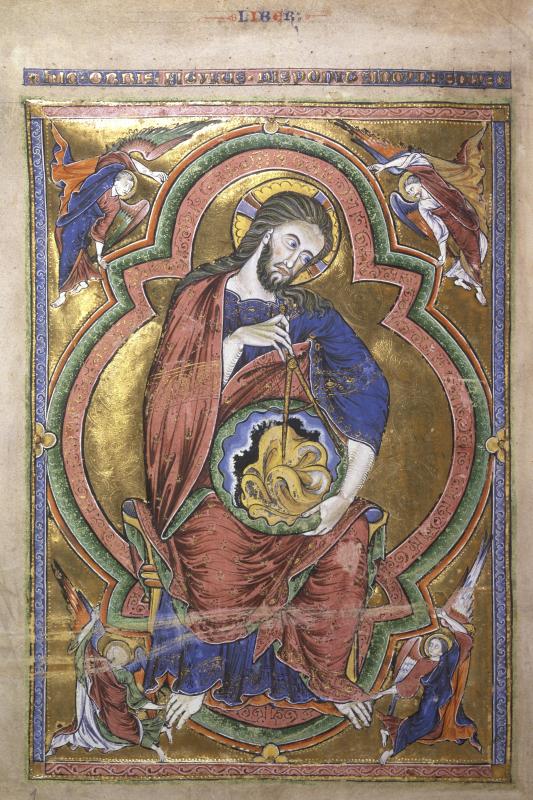One of the earliest scientific books at the Fisher Library is a 14th-century manuscript of the Elements, the famous treatise on geometry written by the Greek mathematician Euclid sometime around 300 BCE. The text of the manuscript - Adelard of Bath’s Latin translation of an Arabic translation of the Greek original - is decorated with ornamental initials and accompanied by intricate mathematical diagrams. The only actual illustration, however, comes in the form of a portrait of the author incorporated into the capital P with which the text begins: a bearded Euclid dressed in red and blue using a pair of compasses to measure a globe.

A modern reader may see here simply a medieval representation of an ancient mathematician, anachronistically dressed perhaps, but perfectly recognisable. A medieval reader, however, would almost certainly have seen something more ambiguous - Euclid, yes, but Euclid depicted as a strikingly Christ-like figure. For all the details included in the portrait, from the beard to the colour of the clothes to the compasses to the globe, are more commonly found in medieval depictions of Christ the Geometer, who, at the creation of the world, "with a compass enclosed the depths and established the sky above."

But why would a medieval illuminator wish to depict Euclid as Christ?
To answer this question, we must consider the relationship between pagan and Christian literature in the Middle Ages. In the works of medieval (and even earlier) Christian authors, admiration for pagan literature was mingled with suspicion and even hostility. In the 3rd century, Tertullian famously asked: "What has Athens to do with Jerusalem? What has the academy to do with the church?" And Augustine, despite his very real appreciation of and indebtedness to pagan literature, deplored the time he had wasted on pagan texts in his youth, a sentiment also found in Jerome and many later Christian writers. Both Augustine and Jerome, however, proved ambivalent in their rejection of pagan learning, the latter suggesting that it could be made to serve Christianity, and the former justifying its study by comparing this pursuit to the plundering of Egyptian gold by the Israelites during the Exodus.
For much of the Middle Ages, texts dealing with mathematics specifically were able to navigate these potentially treacherous waters with relative ease. In the Latin west, at least, no complete mathematical treatises survived from antiquity. Instead, mathematical texts took the form of composite works, drawing partly from ancient theoretical treatises such as Euclid’s Elements, partly from ancient practical guides to topics such as surveying, and partly from more recent, non-mathematical works that nevertheless included some mathematical material. Some of the texts in this last group, such as Augustine’s commentary of Genesis, had Christian authors, and the composite nature of early medieval mathematical works made it easy for their compilers to insert as much additional Christian material as they desired.
Adelard’s translation of Euclid’s Elements enjoyed no such flexibility: it was a purely pagan text. But while there may have been little room for manoeuvre in terms of content, there was nothing to prevent the makers of individual copies of the Elements, such as the manuscript housed at the Fisher, from including extra-textual details that cast the work in a Christian context. And so we find our Christ-like Euclid placed prominently on the first page, a reminder to the reader to approach this text from a Christian point of view. This is not to say, of course, that Euclid is being claimed as a proto-Christian author - a figure like Virgil in Dante’s Commedia - let alone being equated with the Christian god. After all, there are important differences between the traditional iconography of the divine geometer and the depiction of Euclid in the manuscript. Most notable is the inclusion in the latter of a level and plumb line along with the compasses. A level and plumb line never appear in depictions of Christ and point rather to the practical, human application of geometry to a Christian purpose: these tools are associated medieval art with architect-builders, and the greatest achievement of medieval architecture in Europe is the cathedral.
The modern world often views science and religion as entirely separate, even as antithetical to each other. For the thousand years of the Middle Ages in Europe this was far from the case. Rather, the relation between the two tended toward the symbiotic: the study of science was structured by religion - there was a long tradition, for example, of essentially scientific commentaries on the first chapter of Genesis; and the study of Christian theology could be augmented by scientific knowledge - if God applied geometric principles to the creation of the world, then an understanding of those principles should aid in interpreting that divine act. What we may think of as two ways of looking at the world - the religious and the scientific - were, to the medieval mind, one. We should not be surprised, therefore, to find a Christianized Euclid waiting for us at the beginning of a 14th-century copy of the Elements.
- Timothy Perry, Medieval Manuscripts and Early Books Librarian
This blog post is part of a series devoted to celebrating Science Literacy Week.
